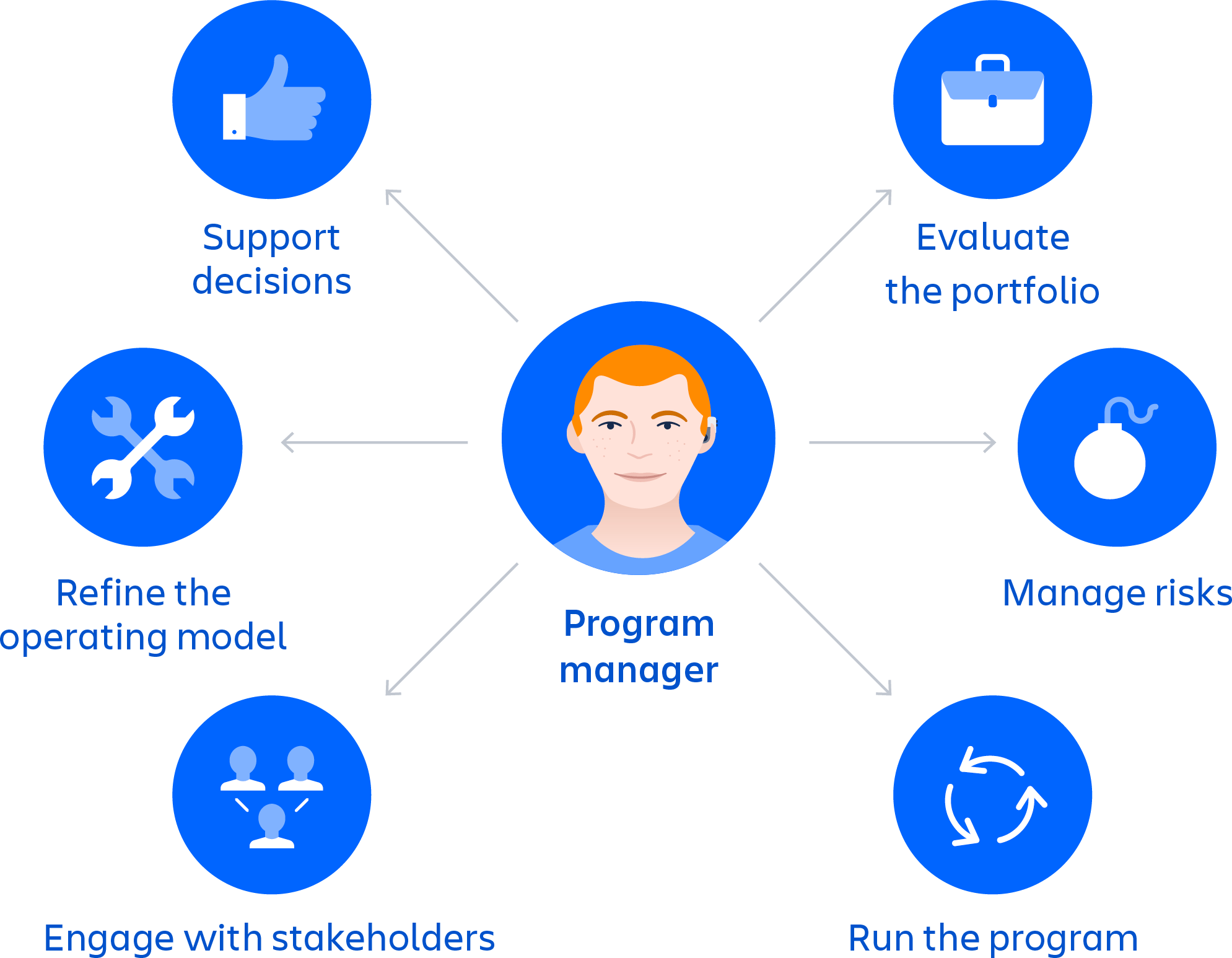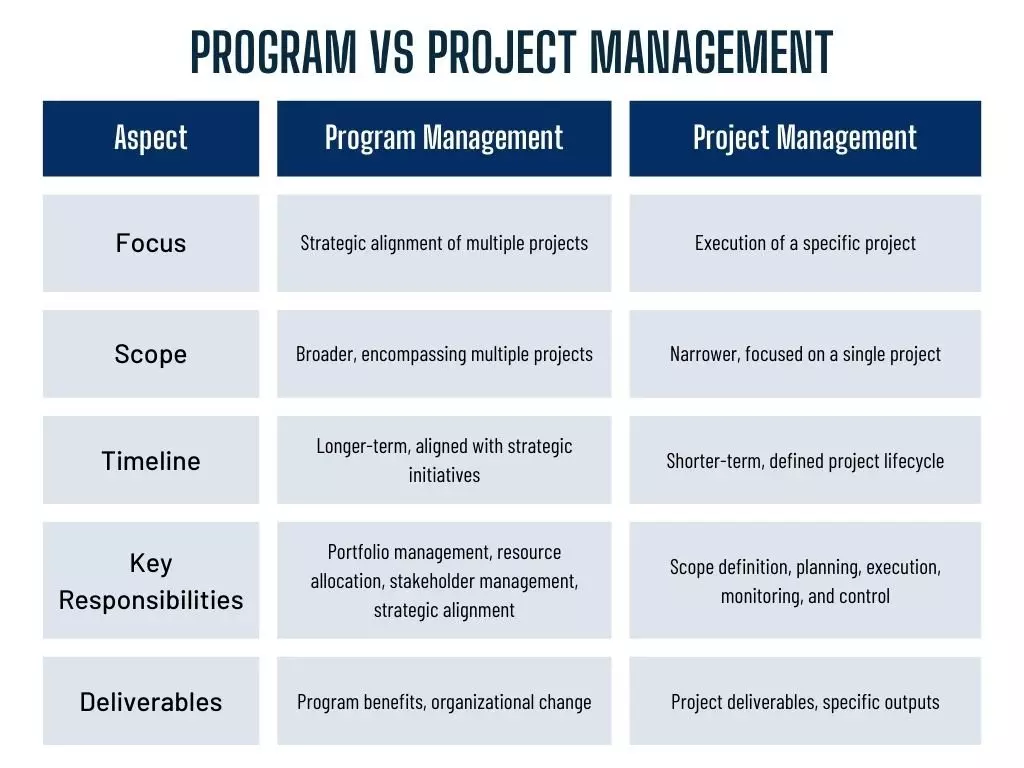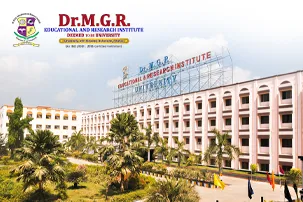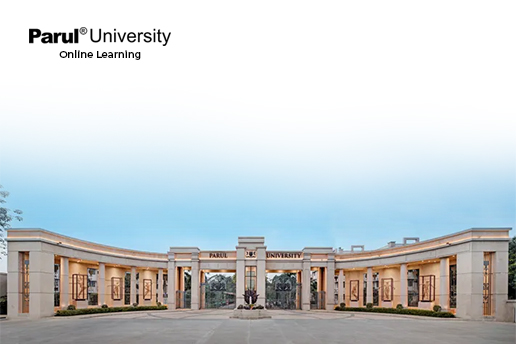What is Program Management: Definition, Benefits & Examples
Table of Contents

In the current age of speed and competition in business, organizations are perpetually balancing multiple projects, stakeholders, and strategic objectives. Without a formal process in place, even the most promising projects can go off course, over budget, or underperform in the long run. This is where Program Management enters the picture—offering a formalized process that aligns projects with business strategy so that every effort translates into organizational success.
Whereas project management deals with a single initiative with defined scope and timeline, program management looks at a portfolio of related projects, ensuring synergy, efficiency, and larger-picture results. Most professionals looking for program manager jobs find that this job is less about executing day-to-day tasks and more about bridging strategy and execution. A clearly articulated program manager job description usually emphasizes leadership, stakeholder management, and the capacity to drive business impact across several projects.
The purpose of this blog is to break down the essentials—what Program Management really means, the benefits of program management, and how it plays out in practice. Through clear explanations and a Program Management example, you’ll see why businesses rely on this discipline to achieve sustainable growth and innovation.
What is Program Management?
Program Management is the organized way of managing several related projects to help meet long-term business goals. According to key frameworks, it includes planning, oversight, and governance to ensure that projects not only finish on time but also fit the larger strategic vision of the organization. Unlike project management, which centers on a single deliverable with a specific scope, program management focuses on integrating results to create a lasting impact.
In practice, programs aim to provide value that goes beyond completing individual projects. For instance, one project may introduce a new software platform while another trains employees to use it effectively. Together, under Program Management, these projects bring about organizational change. This marks an important difference: projects meet short-term goals, while programs produce long-term strategic results.
Those in program manager jobs are responsible for making sure every project supports the company’s mission. A typical program manager job description includes duties like coordinating teams across departments, managing budgets, addressing risks, and working with stakeholders at every level. In addition to executing plans, program managers must also measure success based on business goals, not just project milestones.
The benefits of program management are considerable. It leads to better resource use, minimizes duplicated efforts, and gives leaders a clear plan for achieving strategy. For example, a Program Management example could be a company starting a digital transformation program where multiple IT, HR, and operations projects work together to modernize the organization and boost efficiency.

Program Management vs Project Management
Whereas commonly used synonymously, Program Management and project management are significantly different in purpose for an organization. Program management is ultimately about the grand scheme of things—synchronizing multiple related projects to achieve long-term strategic objectives. Project management is tactical in nature, concentrating on executing discrete deliverables within specified scope, time, and budget.
Imagine it as an orchestra. Program Management is the conductor, making sure all sections—strings, brass, percussion—play harmoniously to produce a symphony. Each section, such as the violins or drums, is a project, with the goal of playing its part well. Without the conductor, the music would have no direction; without the musicians, there would be no performance.
Professionals in program manager careers are responsible for facilitating this orchestration so that every moving part serves strategic goals. The usual program manager career description emphasizes duties such as cross-project coordination, alignment with stakeholders, and business impact measurement. Project managers, by contrast, are concerned with scheduling tasks, managing risks, and team delivery.
The advantages of program management become more apparent in this comparison—it fosters synergy, removes redundancies, and establishes value that goes beyond the success of projects. For instance, a Program Management example might be a sustainability initiative company-wide, with distinct projects such as waste minimization, energy efficiency, and green supply chains all contributing to a larger vision.
| Aspect | Project Management | Program Management |
|---|---|---|
| Focus | Specific Deliverables | Strategic business outcomes |
| TimeFrame | Short-term | Long-term |
| Scope | Single Project | Multiple related projects |
| Role | Execution & Delivery | Alignment, coordination, and strategy |
| Example | Launching a Delivery app | Driving company-wide digital transformation |

Major Benefits of Program Management
Among the most significant advantages of program management is its strong organizational alignment. By connecting projects directly with strategic objectives, Program Management makes all effort count towards long-term business priorities instead of one-off victories. This helps firms implement their strategies and stay focused even in complicated environments.
The other benefit is greater efficiency and fewer duplications. Lacking a program-level perspective, various projects could overlap efforts or struggle with shared resources. With program guidance, overlaps are avoided, and steps are consolidated. Most people seeking program manager positions discover that one primary role is to discover such synergy and eliminate roadblocks.
Improved resource utilization is also an essential result. Rather than allocating resources to a project-by-project basis, a program manager groups people, budgets, and tools across several initiatives. A program manager job description usually emphasizes this capacity for prioritization, balancing the deployment of resources to the greatest impact.
Concurrently, program-level risk mitigation avoids issues in one project from sabotaging the entire plan. Program managers evaluate risks across projects and develop contingency strategies ahead of time. Such a formal approach promotes resilience.
Increased visibility and reporting to the leadership is another significant advantage. With unified dashboards and performance monitoring, executives have a clear view of how initiatives are tracking against strategic goals.
Last but not least, creation of long-term value for the firm differentiates program management. While standalone projects produce near-term results, programs produce long-term results. An excellent Program Management example might be a corporation’s global sustainability program, where several projects in energy conservation, waste reduction, and supply chain enhancements produce long-term business value.
Program Management Frameworks & Methodologies
To deliver consistent outcomes, organizations often rely on structured Program Management frameworks and methodologies. One of the most widely used is MSP (Managing Successful Programmes). This framework is flexible and principle-based, making it suitable for large-scale change initiatives. It emphasizes governance, stakeholder engagement, and benefit realization—key elements found in most program manager job descriptions.
Another well-known standard is the PMI’s Standard for Program Management. This standard provides guidelines that are recognized globally for program planning, governance, and delivery. Many professionals preparing for program manager jobs use this framework to align their practices with international best practices.
For organizations that embrace agility, the Scaled Agile Framework (SAFe) is particularly effective. SAFe combines Program Management with Agile practices. This allows organizations to coordinate multiple teams while keeping strategic alignment. This approach delivers the benefits of program management, such as efficiency and risk management, while also maintaining the flexibility of Agile.
When choosing a framework, context is important. MSP is best for transformation programs, PMI’s standard is suitable for traditional industries that seek global consistency, and SAFe is ideal for tech-driven environments managing iterative development. Hybrid models are becoming more common, where program managers blend predictive planning with Agile execution.
For example, in a Program Management example like digital transformation, MSP can ensure governance, SAFe can drive Agile delivery, and PMI standards can guide reporting. This integration helps meet strategic goals while adapting to changing business needs.
Program Management Process: Step-by-Step
A structured Program Management process helps organizations achieve both short-term project successes and long-term strategic goals. While the specific steps may differ by framework, most programs follow four main stages.
1. Define the Program
This process starts with creating a clear vision, goals, and scope. At this point, the organization decides how the program will support strategic objectives. This is where program managers concentrate on meeting business needs and expected outcomes.
2. Plan the Program
After defining the program, the planning phase sets out roadmaps, governance structures, and how resources will be allocated. A detailed plan offers clarity on timelines, dependencies, and decision-making processes. Program managers often have responsibilities for developing this structure and making sure all teams understand their roles.
3. Execute and Monitor
During this phase, projects are launched and managed under the program’s supervision. Program managers keep track of progress, address risks, and communicate with stakeholders regularly. The advantages of program management become clear, as coordination across various projects reduces overlap and ensures that efforts complement each other.
4. Close and Evaluate
In the final stage, the focus is on finishing the program, measuring success against set goals, and capturing lessons learned. Tracking the realization of benefits makes sure the organization gains long-term value from the program. A strong example of Program Management would be a company that completes a sustainability program and then reports measurable reductions in carbon footprint and cost savings.
Skills & Qualities of an Effective Program Manager
To achieve lasting impact, program managers need a mix of technical and leadership skills. Strategic thinking and a solid understanding of business help them link multiple projects to the organization’s goals. A typical job description for a program manager emphasizes leadership and people management, as they must inspire teams across different areas and promote collaboration.
Communication and stakeholder engagement skills are also vital. A successful program manager builds trust, resolves conflicts, and keeps everyone updated. Managing risks and changes is essential too. The advantages of program management are realized when risks are spotted early and changes are handled smoothly across projects.
Finally, the ability to make decisions in uncertain situations sets great program managers apart. In rapidly changing environments, they must weigh options and make choices that protect strategic results. A strong example of this in Program Management is seen in large transformation initiatives, where program managers guide organizations through complex changes confidently.
Real-World Examples of Program Management
Example 1: Digital Transformation in Banking
A global bank launched a program to upgrade its IT systems. While individual projects worked on upgrading applications and migrating data, Program Management ensured they aligned with regulatory compliance and customer experience goals. This shows how program management can drive long-term efficiency.
Example 2: Urban Infrastructure Development
In the public sector, a government started an urban infrastructure program that included roads, public transport, and smart utilities. Program managers oversaw multiple projects, ensuring proper resource distribution, stakeholder engagement, and governance. Many program manager roles in such projects focus on balancing political, social, and economic concerns.
Example 3: Global Market Expansion
A corporation’s entry into international markets needed coordinated projects for supply chains, marketing, and compliance. The program manager’s role involved managing cross-border teams, reducing risks, and maintaining a consistent brand. This Program Management example shows how organized oversight enables smooth expansion.
These examples highlight how program managers help organizations carry out their strategy, lower risks, and create lasting value.
Conclusion
Program Management is much more than managing several projects—it is a discipline for matching execution with business strategy to create long-term value. Through knowing its definition, advantages of program management, and how it is different from project management, organizations can position themselves better for growth and change. A well-defined program manager job description emphasizes skill areas such as leadership, communication, and risk management, all of which are critical for success in today’s complex settings.
From digital change to public infrastructure, each Program Management example illustrates the way thoughtful oversight transforms separate projects into combined success. For those career-seekers investigating program manager careers, command of these practices creates a gateway to meaningful leadership opportunities. Organisations should now embrace effective program management tools and frameworks to enhance alignment, mitigate risk, and develop sustainable results.
Frequently Asked Questions
What is meant by program management?
Program management involves managing multiple related projects to achieve long-term goals. It ensures that the organization’s vision matches the execution of projects.
What are the top 3 skills of a program manager?
The key skills of a program manager include strategic thinking, leadership, and stakeholder management. These skills help them drive results, lead teams, and connect projects with business goals.
What is an example of program management?
An example of program management is a company launching a digital transformation initiative with multiple projects—such as IT upgrades, process automation, and workforce training. Together, these deliver organisational efficiency and growth.
What does a program manager do?
A program manager oversees interrelated projects, manages resources, and ensures benefits realisation. They act as a bridge between strategy and execution, aligning project outcomes with business goals.
Why is program management important?
Program management is important because it improves efficiency, reduces risks, and ensures strategic alignment. It enables organisations to deliver long-term value and achieve growth in a structured way.

















